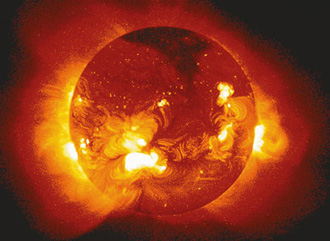 Solar power: is it the ray of the future?
Solar power: is it the ray of the future?
Q: Question for chemistry professor Scott Cummings: Burning fossil fuels presents a host of challenges: petroleum prices are rising while reserves are dwindling, and the carbon dioxide emissions from burning both oil and coal are affecting the global climate. What better fuels will we turn to in the future?
A: The most visible problem with petroleum is "peak oil"--the expectation that global oil production rates will peak within the decade. A "solar solution" to our oil addiction is to shift away from using fuels made from petroleum and toward solar fuels that are generated using sunlight, such as hydrogen and ethanol. Neither hydrogen nor ethanol is an energy source, but they both can be thought of as energy carriers--like electricity, but more portable.
There's been a lot of buzz about ethanol. Growing corn or switchgrass for ethanol uses energy from the sun, but the agricultural and production processes rely on fossil fuels. The challenge to using ethanol as a solar fuel is finding ways to use fossil fuel energy less than we currently do.
Hydrogen is perhaps the most promising clean fuel. In a hydrogen economy, hydrogen gas is used to power fuel cells to produce electricity. The problem is, where are you going to get the hydrogen? We currently make hydrogen fuels by reacting methane with steam, but methane is itself a fossil fuel, and this process emits carbon dioxide.
The long-term vision of a hydrogen economy involves making hydrogen from water. It's possible to take water, break it apart into hydrogen gas and oxygen gas, store the hydrogen gas as a fuel, and react it in fuel cells, with water as the byproduct. It's almost a perfect cycle. The barrier to developing hydrogen as a solar fuel is finding efficient ways to produce it using sunlight to split water into hydrogen and oxygen, rather than relying on natural gas as the hydrogen source or nuclear or coal as the energy source.
That brings up the larger problem of using fossil fuels, especially coal, to generate electricity. There is no shortage of available coal, but coal combustion results in the emission of carbon dioxide. A "solar solution" to this problem is to shift toward photovoltaics--solar panels--to generate electricity.
We see more energy from the sun in one hour than our entire civilization uses in a year. We have vast amounts of energy streaming onto us for free. Solar is everlasting. It's free for everyone, and it's probably one of the most democratic fuels. Some people call solar energy "power to the people."
We know solar electricity works. In most markets, it's more expensive than generating electricity from coal or nuclear, but the economics could quickly shift with the large-scale production of solar panels. Current solar panels made from crystalline silicon are expensive, but the next generation of panels will be thin films that are much easier--and much less expensive--to make. The large solar panels on roofs will become invisible because they will be almost seamlessly integrated into the design of the home.
With solar, the future's here. And countries like Germany and Japan are leading the way. In Japan, it's less expensive to generate electricity from solar panels than it is to generate electricity from fossil fuels. I think that, in the future, we're going to see the scales tipped definitely in favor of solar energy.
Associate Professor of Chemistry Scott Cummings recently designed a new course, "Solar Energy," dealing with energy issues.
Do you have feedback on this page?
